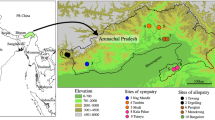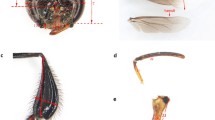Abstract
A recent isolated population of Apis florea has been reported from Aqaba in Jordan at the Red Sea, consisting of numerous colonies within a still limited range which apparently is expanding. This region is about 1500 km apart from its next occurrences in Sudan where it had been introduced and first detected in 1985 and about 2000 km apart from its next natural occurrences in Iran and Oman. These bees apparently have been imported by human transport, most likely by ship. This new location thus represents a major jump in the progression of the species still to fill a wide area of possible locations offering adequate living conditions. Here we attempt to track the possible origin of this new population by morphometric methods. This analysis indicated closest relation to A. florea from Oman, thus being the most likely source of this population.
Zusammenfassung
Vor kurzer Zeit wurde ein aus zahlreichen Völkern in einem begrenzten Areal bestehendes Vorkommen von Apis florae in Aqaba, Jordanien aufgefunden, etwa 1500 km von seinen nächsten Nachbarn im Westen und 2000 km von denen im Osten entfernt.
Um die mögliche Herkunft dieser neuen Population zu bestimmen, führten wir eine Hauptfaktorenanalyse anhand von 10 an 870 einzelnen Arbeiterinnen aus 50 Völkern von 28 Herkunftsorten gewonnenen morphometrischen Merkmalen durch (Abb. 1 und zusätzliches Onlinematerial zu den Herkunftsorten). Das Hauptkomponentendiagramm zeigte zwei getrennte Morphokluster, von denen der erste von kleineren Bienen von Südindien und Sri Lanka, der zweite von größeren Bienen aus Iran in einer Abseitsposition und von den Bienen aus Sudan, Oman, Jordanien und Pakistan gebildet wurde. In den Diagrammen einer die Koloniemittelwerte aus den 6 Ländern mit mehr als einem Volk und die gleichen 10 morphometrischen Merkmale umfassenden Diskriminanzanalyse lagen die Völker aus Jordanien und Sudan innerhalb der gleichen 90 % Vertrauensellipse mit den Völkern von Pakistan und Oman (Abb. 2). Die quadrierten Mahalanobisabstände der Gruppenzentroide zeigten, das die Völker aus Jordanien höchstwahrscheinlich über Oman eingeführt wurden (Tab. I), dies erfolgte wahrscheinlich per Schiff.
Similar content being viewed by others
References
Abe T. (2006) Threatened pollination systems in native flora of the Ogasawara (Bonin) Islands, Ann. Bot. 98, 317–334.
El-Shafie H.A.F., Mogga J.B.B., Basedow T.H. (2002) Studies on the possible competition for pollen between the honey bee, Apis mellifera sudanensis, and the imported dwarf honey bee Apis florea (Hym., Apidae) in North-Khartoum (Sudan), J. Appl. Entomol. 126, 557–562.
Haddad N., de Miranda J.R., Bataena A. (2008) Discovery of Apis florea in Aqaba, Jordan, J. Apic. Res. 47, 173–174.
Hepburn H.R., Radloff S.E., Otis G.W., Fuchs S., Verma L.R., Tan K., Chaiyawong T., Tahmasebi G., Wongsiri S. (2005) Apis florea: morphometrics, classification and biogeography, Apidologie 36, 359–376.
Howard L.O. (1930) A history of applied entomology, Smtihsonian Institution, Washington.
Johnson R.A., Wichern D.W. (2002) Applied Multivariate Statistical Analysis, Fifth Edition, Prentice Hall, Upper Saddle River, New Jersey.
Kato M., Kawakita A. (2004) Plant-pollinator interactions in New Caledonia influenced by introduced honey bees, Am. J. Bot. 91, 1814–1827.
Kearns C.A., Inouye D.W., Waser N.M. (1998) Endangered mutualisms: The conservation of plant-pollinator interactions, Annu. Rev. Ecol. Syst. 29, 83–112.
Mogga G.B., Ruttner F. (1988) Apis florea in Africa; source of the founder population, Bee World 69, 100–103.
Pedigo L.P., Rice M. (2008) Entomology and pest management, Pearson, London.
Ruttner F. (1988) Biogeography and taxonomy of honeybees, Springer, Berlin.
Samways M.J. (1994) Insect conservation biology, Chapman & Hall, London.
Soares A.E.E., De Jong D. (1992) Pesquisas com Abelhas no Brasil, Revista. Brasileira de Genetica., Ribeirao Preto SP, 680 p.
StatSoft, Inc. (2007) STATISTICA, version 8.1, www.statsoft.com (accessed on 2 March 2009).
Winston M.L., Dropkin J.A., Taylor O.R. (1981) Demography and life history characteristics of two honey bee races (Apis mellifera), Oecologia 48, 407–413.
Wongsiri S., Lekprayoon C., Thapa R., Thirakupt K., Rinderer T.E., Sylvester H.A., Oldroyd B.P., Booncham U. (1996) Comparative biology of Apis andreniformis and Apis florea in Thailand, Bee World 77, 23–35.
Author information
Authors and Affiliations
Corresponding author
Additional information
Manuscript editor: Walter S. Sheppard
Rights and permissions
About this article
Cite this article
Haddad, N., Fuchs, S., Hepburn, H.R. et al. Apis florea in Jordan: source of the founder population. Apidologie 40, 508–512 (2009). https://doi.org/10.1051/apido/2009011
Received:
Revised:
Accepted:
Issue Date:
DOI: https://doi.org/10.1051/apido/2009011




